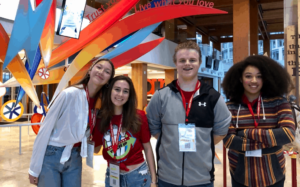Blended STEM: Project Lead The Way

Project Lead the Way (PLTW) is a leading provider of STEM curriculum for U.S. secondary schools. PLTW is launching an elementary program, a computer science strand, and improving its blended STEM offering with updates to the online and hands-on learning experience.
Dr. Vince Bertram leads the team behind the aggressive agenda. Bertram, who has been CEO for two years, was superintendent in Evansville for four years and a high school principal in Lafayette, Indiana before that.
PLTW is in more 4,700 schools in all 50 states. The middle school Gateway To Technology program includes 9 modules of 9 weeks. The high school program, Pathways To Engineering, includes 8 full year courses. There is also a 4 course Biomedical Sciences Program that “explores human medicine, bioinformatics, cell biology, genetics, disease, and other biomedical topics through relevant problem-solving activities.”
The “3 pillars” of PLTW are world-class curriculum, high quality professional development, and a growing and engaged network of universities and companies. “All courses are engaging and project-based–it’s all about getting them excited about applying math and science,” said Bertram. PLTW designs all the curriculum and brings in industry experts and professors from leading universities in an effort to stay current and reflect best practices.
VEX Robotics powers the middle school and some of the high school PLTW hands-on experience with kits. PLTW classrooms have the opportunity to apply their robotics knowledge by participating in the VEX Robotics Competition, the largest and fastest growing middle and high school robotics competition.
PLTW is growing by about 20% annually–adding over 1,000 programs in 2013. In 2014, PLTW will be adding computer science and software engineering for high school–a popular but dynamic new subject.
Secondary schools benefit from 49 training sites–mostly universities–around country.
The elementary program is a logical but challenging extension that will require more site based training. Bertram notes the big built in market of 20,000 elementary schools in served areas.
In addition to training, university partnerships provide college credit opportunities, recruiting and scholarships.
The Innovation Portal, developed by PLTW with support from the Kern Family Foundation, is a portfolio site (open to all schools) that supports rubric-based scoring of original design and problem solving work. The intent is to support e-portfolio use by university in admissions.
While foundation support has been key for PLTW development, schools pay a fee to participate making the program close to self-sustaining. Schools join to access STEM content, they stay because it works. Dozens of studies of PLTW are summarized in a paper by Dr. Robert Tai. They suggest that PLTW students take more math and science, get better grades, go to college and major in STEM fields at higher rates than other students.
Last month, PLTW chose Canvas as its learning management system, a decision likely to be a turbo booster for Canvas (from Instructure) in K-12.
As noted last week, PLTW moved to Indianapolis last year with some encouragement from Governor Daniels and Superintendent Bennett. With 400 participating schools, Indiana is the largest PLTW state.






0 Comments
Leave a Comment
Your email address will not be published. All fields are required.